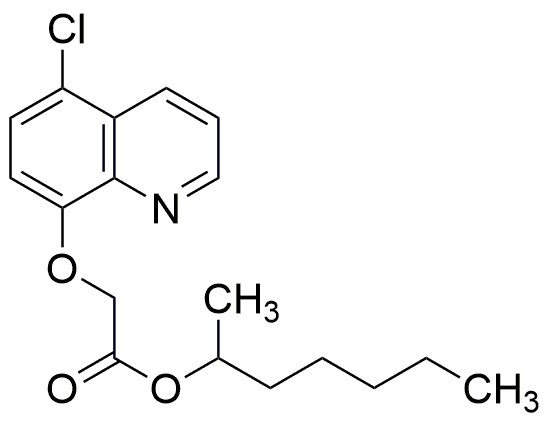Cloquintocet-mexyl is widely utilized in research focused on:
- Agricultural Herbicide: It serves as a selective herbicide in various crops, particularly in cereals, helping farmers manage weed populations effectively while minimizing damage to crops.
- Crop Protection: The compound enhances the efficacy of other herbicides, allowing for lower application rates and reduced environmental impact, which is crucial for sustainable farming practices.
- Research on Herbicide Resistance: Scientists study its mechanisms to better understand and combat herbicide-resistant weed species, providing insights that can lead to more effective weed management strategies.
- Formulation Development: It is used in the development of advanced pesticide formulations, improving stability and performance, which is essential for manufacturers looking to create competitive products.
- Environmental Impact Studies: Researchers assess its environmental behavior and degradation pathways, contributing to regulatory assessments and ensuring safe use in agricultural practices.
Informations générales
Propriétés
Sécurité et réglementation
Applications
Cloquintocet-mexyl is widely utilized in research focused on:
- Agricultural Herbicide: It serves as a selective herbicide in various crops, particularly in cereals, helping farmers manage weed populations effectively while minimizing damage to crops.
- Crop Protection: The compound enhances the efficacy of other herbicides, allowing for lower application rates and reduced environmental impact, which is crucial for sustainable farming practices.
- Research on Herbicide Resistance: Scientists study its mechanisms to better understand and combat herbicide-resistant weed species, providing insights that can lead to more effective weed management strategies.
- Formulation Development: It is used in the development of advanced pesticide formulations, improving stability and performance, which is essential for manufacturers looking to create competitive products.
- Environmental Impact Studies: Researchers assess its environmental behavior and degradation pathways, contributing to regulatory assessments and ensuring safe use in agricultural practices.
Documents
Fiches de données de sécurité (FDS)
La FDS fournit des informations de sécurité complètes sur la manipulation, le stockage et l’élimination du produit.
Spécifications du produit (PS)
Le PS fournit une description complète des propriétés du produit, notamment sa composition chimique, son état physique, sa pureté et les exigences de stockage. Il détaille également les plages de qualité acceptables et les applications prévues du produit.
Certificats d'analyse (COA)
Recherchez des certificats d'analyse (COA) en saisissant le numéro de lot du produit. Les numéros de lot et de lot se trouvent sur l'étiquette d'un produit, après les mots « Lot » ou « Lot de fabrication ».
Numéro de catalogue
Numéro de lot/série
Certificats d'origine (COO)
Ce certificat d'exploitation confirme le pays dans lequel le produit a été fabriqué, et détaille également les matériaux et composants utilisés et s'il est issu de sources naturelles, synthétiques ou autres sources spécifiques. Ce certificat peut être requis pour les douanes, le commerce et la conformité réglementaire.
Numéro de catalogue
Numéro de lot/série
Fiches de données de sécurité (FDS)
La FDS fournit des informations de sécurité complètes sur la manipulation, le stockage et l’élimination du produit.
DownloadSpécifications du produit (PS)
Le PS fournit une description complète des propriétés du produit, notamment sa composition chimique, son état physique, sa pureté et les exigences de stockage. Il détaille également les plages de qualité acceptables et les applications prévues du produit.
DownloadCertificats d'analyse (COA)
Recherchez des certificats d'analyse (COA) en saisissant le numéro de lot du produit. Les numéros de lot et de lot se trouvent sur l'étiquette d'un produit, après les mots « Lot » ou « Lot de fabrication ».
Numéro de catalogue
Numéro de lot/série
Certificats d'origine (COO)
Ce certificat d'exploitation confirme le pays dans lequel le produit a été fabriqué, et détaille également les matériaux et composants utilisés et s'il est issu de sources naturelles, synthétiques ou autres sources spécifiques. Ce certificat peut être requis pour les douanes, le commerce et la conformité réglementaire.


